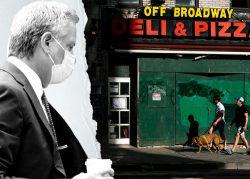UPDATED Oct. 5, 2020, 3:51 pm: Gov. Andrew Cuomo is redrawing the city’s shutdown zones to better target Covid hotspots.
He shared his plan Monday after Mayor Bill de Blasio proposed to dial back reopening in 20 ZIP codes where 3 percent to 8 percent of coronavirus tests have come back positive over the past week.
Read more



Cuomo instead called the breakdown by ZIP code “imperfect,” showing a map of one in Brooklyn where positive tests were concentrated in a section of it.
“The ZIP code as a template is rough justice,” Cuomo said. “We can refine that. It takes some review and analysis.”
That review, which he indicated will take a day or two, will affect which businesses face lockdowns.
De Blasio said Monday that he will continue preparations for implementing his plan until the Cuomo administration comes up with its own.
“I do not expect the state to delay for long, but they may modify in some way, in which case we’ll adapt accordingly,” the mayor said.
The governor said he plans to meet with leaders of the Orthodox community, which has seen spikes in coronavirus cases, to solicit their help in enforcing mask-wearing and social distancing. If they refuse, Cuomo said, he will close synagogues.
“This is the last thing I want to do,” Cuomo said. “It’s a difficult conversation.”
If they agree, outdoor activities will continue to be allowed, as well as some indoor activities with capacity limits, he said, laying out a potential compromise. The Covid hotspots were in many cases in Hasidic neighborhoods.
De Blasio on Sunday said he would seek state approval to dial back reopening in nine ZIP codes and put 11 others on notice. Indoor dining at 50 percent capacity had resumed only Sept. 30 in the five boroughs. Cuomo said it would be unfair to close businesses in low-Covid areas just because they shared a ZIP code with a high-Covid area.
Cuomo did agree with de Blasio that schools in nine New York City ZIP codes would close tomorrow. He said a detailed analysis of positive tests could not be done before then. But he noted that a given school might draw students from a catchment area that overlaps very little with the local ZIP code.
